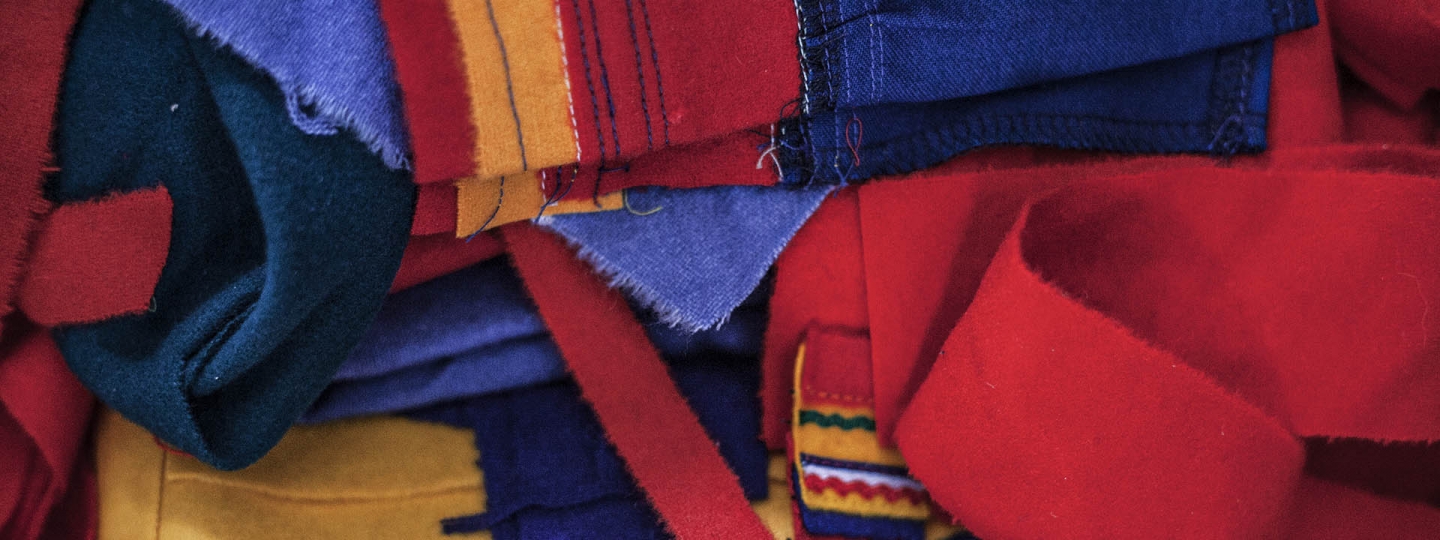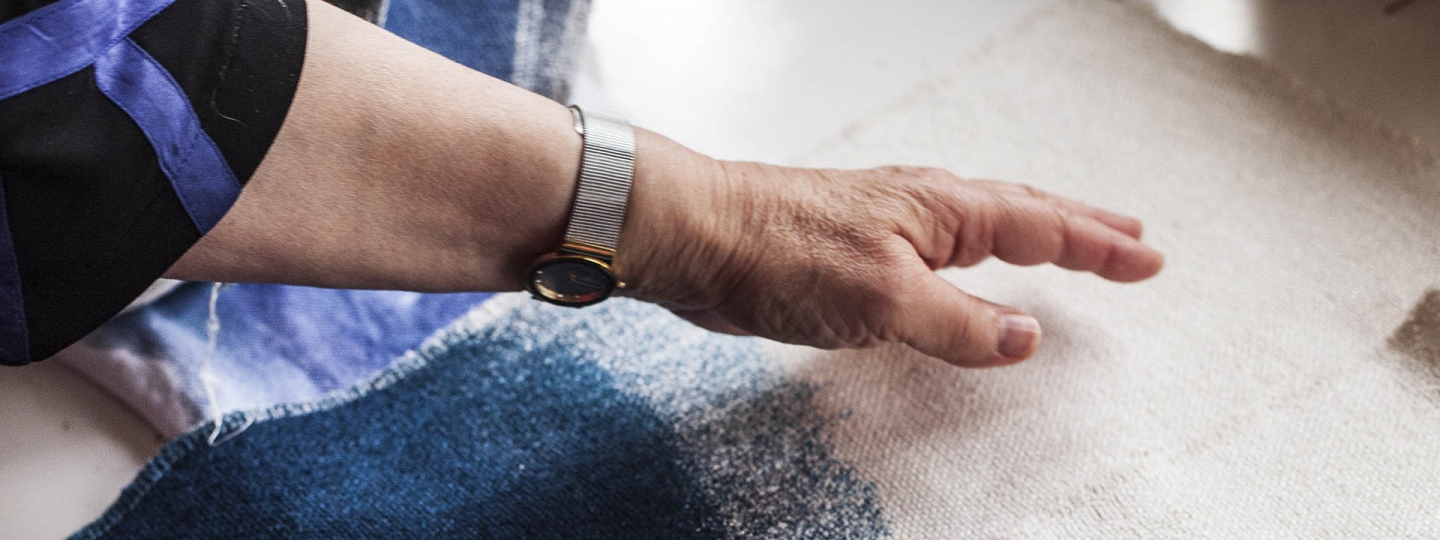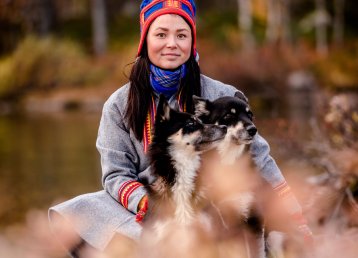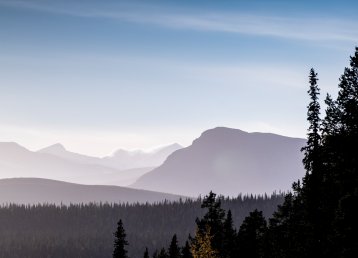The needle powerfully penetrates the white cloth, almost like a skier moving across untouched, white snow where poles and skis sink into the newly fallen snow to slowly create a pattern. The skier – or the needle – slowly embroiders Sámi history. Huts and snowmobiles, shamans and deforested land, reindeer and humans, the mundane and the mythical, good and evil. Everything finds its place in Britta Marakatt-Labba’s embroidery. Today, as we meet her in her home in Övre Soppero, she has just returned from a European trip. Despite 40 years of diligent work, it took an international breakthrough to get noticed in Swedish cultural life. An international breakthrough simultaneously as other artists in Sámi contemporary life was given more space. With people like Anders Sunna and Sofia Jannok, the film Sámi Blood (‘Sameblod’) and the August Prize winner, Linnea Axelsson’s Ædnan, the Sámi have begun to gain their rightful place in general culture.
– Yes, but I worry it’s just a wave, a trend, and that we’ll soon be forgotten again, says Britta while she cooks mashed potatoes and suovas.
— When you’ve driven that far, you have to eat something. Would you like gáhkku and coffee first?
I say yes, please, of course. Sámi culture is a culture of hospitality, and I would be crazy to say no, especially when offered home-baked bread and home-made mashed potatoes by a popular Swedish artist. As I sit down, drinking my coffee, I wonder if all the curators and managers from the world’s art galleries and museums, who are on their way to Övre Soppero, will be as lucky. Then I have a refill.
40 years’ worth of work
When Britta started with her art in the 1970s, she first finished a program at a residential college for adult education in Sunderbyn, Luleå, then moved on to HDK-Valand, Academy of Art Design, at the University of Gothenburg – people could hardly believe their eyes. Embroidery wasn’t exactly trendy then, and people tended to refer to their grandmother’s old-style kitchen tapestries. Some kind of kitsch.
— Yes, I remember many people wondered. Many said I should paint instead of wasting my time.
— But I liked this. Textile is a material that allows me to express myself.
For Britta, there is a point in taking her time, as it allows for reflection – perhaps we could call it the aesthetics of slowness or the graffiti of gentleness. It goes without saying: if you are making a 24-metre-long tapestry like the famous Historjá at Tromsö University, you have time to think about what it is you want to express. Between 2003 and 2007, Britta worked at that piece of art, where stitches were added to stitches along the path of Sámi history. Historjá was shown at the large art exhibition Documenta in Kassel, Germany, which meant that many people discovered Britta Marakatt-Labba. Internationally it became a huge success, and suddenly the Swedish press also realised that something very special was going on in Övre Soppero. But the world very nearly missed the whole excitement, by a hair’s breadth.
— Yes… well, first, I said I didn’t want to participate. But then a colleague called and said I “had to” participate, that I’d be crazy not to, and then I changed my mind.
— I don’t know what to say. Of course, it’s great to be noticed after 40 years’ worth of work. At the same time, it just takes up so much time.

Idivuoma
Britta was born in Idivuoma in 1951. Her mother had twelve children, two of whom died, and Britta grew up with nine siblings in the Sámi administrative unit Lainiovuoma.
It’s all about images
Britta was born in Idivuoma in 1951. Her mother had twelve children, two of whom died, and Britta grew up with nine siblings in the Sámi administrative unit Lainiovuoma. One Christmas Eve, her father went out to see to his reindeer and was hit by a taxi from Finland. He died. Britta was five years old. Then she went to the nomad school in Karesuando, which she describes as misery, in a time and town full of racism and contempt towards the Sámi. Then she chose the college for adult education in Sunderbyn, outside Luleå, before continuing to the Academy of Art and Design in Gothenburg. A time she describes as yet another extreme. As a Sámi, she was considered exotic. The two extremes have left their mark: the feeling of being there but never really being part of the context.
The potatoes on the cooker are done, and Britta peels them as we chat. She is careful with details. To make proper mashed potatoes, you should not peel the potatoes before you boil them, “no, then the mash will be watery and tasteless”, you peel them afterwards. The minerals and flavours are left, and it gets thicker.
— I like details and organisation. In that sense, my studio probably doesn’t look like that of other artists, she says and chuckles.
We enter the studio, a fairly simple room, bright and tidy, and not very big.
— Did you make Historjá here?
— Yes, exactly, over there at the table with the pincushions. I had it on a roll and embroidered one length at a time.
— But 24 metres?
— I know, it wasn’t ideal. First, I made a 16-metre section. Then I made another one that was eight metres long. I should have made several sections of four metres each. Instead, that would have been easier.
Everything is about images, images that exist inside Britta’s head, slowly travelling down the white fabric of her embroidery.
Everything is about images, images that exist inside Britta’s head, slowly travelling down the white fabric of her embroidery. She treasures her images. She worries they will disappear. But this is also a practical problem. To get orders from larger institutions, those with money, she needed to be able to show sketches. But Britta was not able to turn her images into sketches; instead, she cut and pasted various collages to show her ideas. Today it is easier; these days, she also makes illustrations.
To tell stories
In the studio, there are some stone sculptures set on wooden logs. I ask who made them, and she answers that she did.
— What?
— Yes, I’ve started going to the stone-polishing workshop in Lannavaara. It’s damn hard work, but it’s fun.
— But what does it feel like? I mean, going from needle and thread and soft fabrics to big noisy machines that polish stone. There is a difference, surely?
— As a child, I loved stones. Our reindeer herding land is in Norway. I used to play with stones there, stones that would become other things in my imagination.
Before I know it, Britta sits down on a low stool in the studio and starts carving wood.
— I have taken a course in wood carving as well. This is how we’d sit in my childhood, around the fire, crafting and telling stories.
As Britta Marakatt-Labba sits carving on her stool, she conveys in a very steadfast manner that she is well aware of not being finished with her art at all. There are lots of things left to do. Many stories left to tell.
When she started with her art, many laughed at her embroidery. They said: “But why don’t you paint instead? You’ll never finish that.” Now she has noticed how a lot of other artists have started with embroidery. But Britta herself has never been interested in anything else but being able to tell her images. “First, I could do it through my embroidery needle. Now I can use other tools too.”
— It is impressive that now that you have the opportunity to make money on your embroidery, you choose other paths or expressions. Why?
— I’m not interested in money. If that had been important to me, I’d never have started embroidering resistance art in the first place. Getting that breakthrough isn’t something that’s been a driving force either.
— But sure, I could travel all the time if I wanted to, talking about myself and my art, you know, lectures, but it’s no fun. I want to tell stories.
The goddess Sáráhkká
1981, once Britta had finished her education in Gothenburg, she joined the protest against the power plant expansion by the Alta River in Norway. She ended up in prison, as did many of the others who protested. One of her first and strongest pieces of art is Garrját, or ‘The Crows’. The crow has always been a symbol of authority to the Sámi, a creature that grabs everything it can. In Garrját, they fly across the protesters in Alta, but as they land, they turn into police officers. The state authority that came there to carry out government work grabbed the rapids, and the land and freedom, and stuffed electricity into its own pocket. Another piece of political work that has received a great deal of attention is Deattán, or ‘Nightmare’. Looking at one of its details, you can see rats invading a Sámi hut. Many are struck by the terrible sight of rats eating the sleeping people around the fireplace, but an equally important symbolism is the number of rats that have invaded the most sacred spot in the hut – the kitchen area. No one was allowed to be there, just the housewife. You could only behave in a certain way there, using certain patterns of movement. The goddess Sáráhkká was the guardian of the home, but also the guardian of female reindeer during calving and pregnant women in the home. Sáráhkká is perhaps the most beloved goddess in Sámi mythology, worshipped by both men and women. Having rats invade her world carries a strong symbolism in Deattán.

Sáráhkká
The goddess Sáráhkká was the guardian of the home, but also the guardian of female reindeer during calving, and pregnant women in the home.
Sámi storytelling
The entire life of the Sámi is based on storytelling. The written word came late, and the oral story carries the culture. As Britta and I talk today, I can hear how she talks in images. For example, when we speak about how it took 40 years of embroidery for her to get a breakthrough, she first says that she has never been keen to change her way of working just because something else has been trendier. How other artists have been inclined to change their form of expression – she uses the word ‘turncoats’ – and then her imagery comes in:
— You know, they’re more like a spring fire jumping from one tuft of old grass to the next. What happens is that those old tufts flare-up; the ground gets slightly burnt, but it doesn’t burn deep.
— Sure, green grass will grow there quickly, but the animals don’t like it. It’s pretty to look at but of little use.
A tree is more than a tree; a fish is not just a fish; a cloudberry is more than just a berry.
Deattán, ‘Nightmare’, is about another kind of violation, not the kind that takes place in public, visible to others. The Sámi live by and from nature and are, in a way, bound to the soul of nature. The rats invading Sáráhkká’s kitchen area is also a violation of Sámi mythology, as it affects the land. A tree is more than a tree; a fish is not just a fish; a cloudberry is more than just a berry.
— When the Sámi picks berries or catch fish, they say a kind of prayer: “Do not let my hands ruin the land that I have borrowed”.
— Life is a constant interaction between event and mythology.
Sámi culture is colourful and ornate in so many ways. Traditional costumes and jewellery are full of expression and provide a parade of colour. But Britta Marakatt-Labba’s art has always been low-key and almost graphic. Why?
— Why? Well, because that’s how I see my images.

























